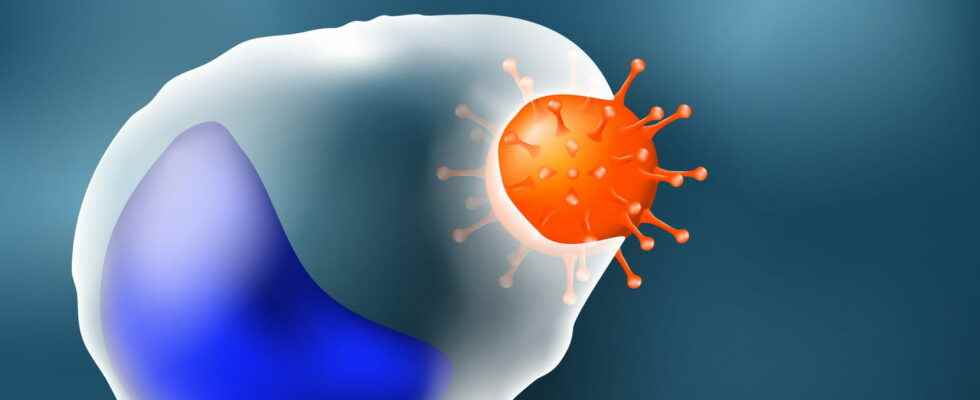Phagocytosis is a biological mechanism that allows cells to internalize and digest particles and microorganisms. It plays a role in defending the body against parasitic infections, bacteria and viruses. Definition, steps and diagram.
Definition: what is phagocytosis?
Phagocytosis is the fact for a cell – the cell being the basic unit of functioning of organisms – to “eat” solid particles or other cells that it finds in its environment: capture, ingest, chew and digest to then use and/or eliminate the ingested material. This analogy comes from the very origin of the word phagocytosis. In Greek, “phagein” means to eat and “kutos” means the cell, the cavity. Literally, this means “to ingest, to swallow a cell”.
Diagram of phagocytosis
What is the role of phagocytosis?
This cellular process will have two functions:
► a first function which is that of maintain the body’s normal balance by eliminating cellular debrisdead cells…”An example of this mechanism: the red blood cells which serve to transport oxygen. Every day our body produces new blood cells and eliminates those that are dying. Thus, 50 to 100 billion red blood cells are eliminated per day by phagocytic cells. explains Florence Niedergang, researcher at the CNRS;
► a second functionmonitoring and activation of the immune system : when it is immune cells that play the role of phagocytosis, they will capture and eliminate micro-organisms, bacteria, etc., and above all they will activate other cells of the immune system. Thus, phagocytosis will participate in the activation of an immune response via the production of soluble mediators.
These two roles can also be requested at the same time. “During an immune response, certain cells – neutrophils – will participate in the elimination of microbes. The latter die very quickly and must absolutely be eliminated in turn by other cells capable of phagocytosis, in order to stop the inflammatory response”. she specifies.
What are the different stages of phagocytosis in an immune cell?
The different stages of phagocytosis in an immune cell are as follows:
► Capture of the target with a range of receptors having affinities to recognize different types of determinants depending on the target: cell debris, bacteria, etc.;
► These receivers then go send a signal to the cell ;
► This cell will reorganize its surface, its membrane: with its skeleton, it will deform to swallow the material in a compartment surrounded by a membrane – this is theinternalization stage ;
► Then, a digestive action takes place : this compartment evolves and will lead to the degradation of its contents by the participation of reactive oxygen species and hydrolytic activities.
Along with this process, cell activation steps are set up around mechanisms for the production and secretion of soluble mediators such as cytokines which will thus alert other cells of the immune system.
What are the biological consequences of phagocytosis?
Phagocytosis makes it possible to participate in the balance of the organism by the elimination of debris and micro-organisms and in the monitoring of the system by activation of an immune response. If it does not work well, the consequences may be to maintain a chronic inflammatory response and having an opportunistic growth of microbes which would no longer be under control since they are no longer eliminated: this may be the case when the phagocytic cell is itself infected by a virus, opportunistic germs can take advantage of this to develop and create bacterial superinfections.
Thanks to Florence Niedergang, researcher at the Cochin Institute (Inserm, CNRS, Université Paris Cité), team leader Biology of phagocytes, infection and immunity, Paris
